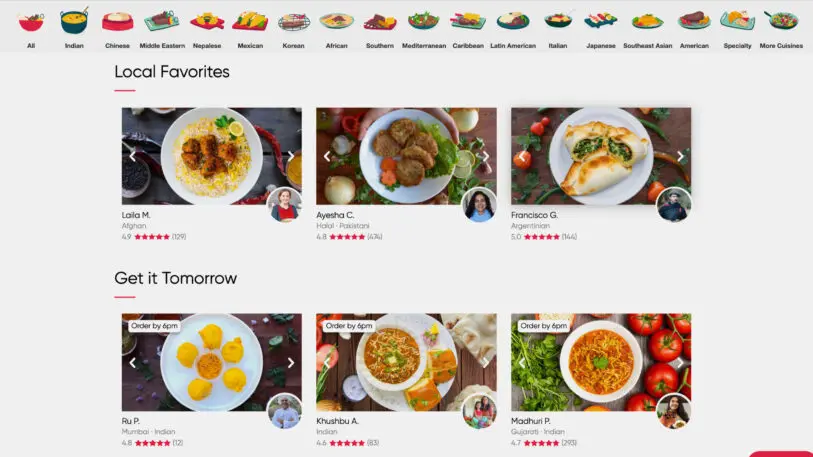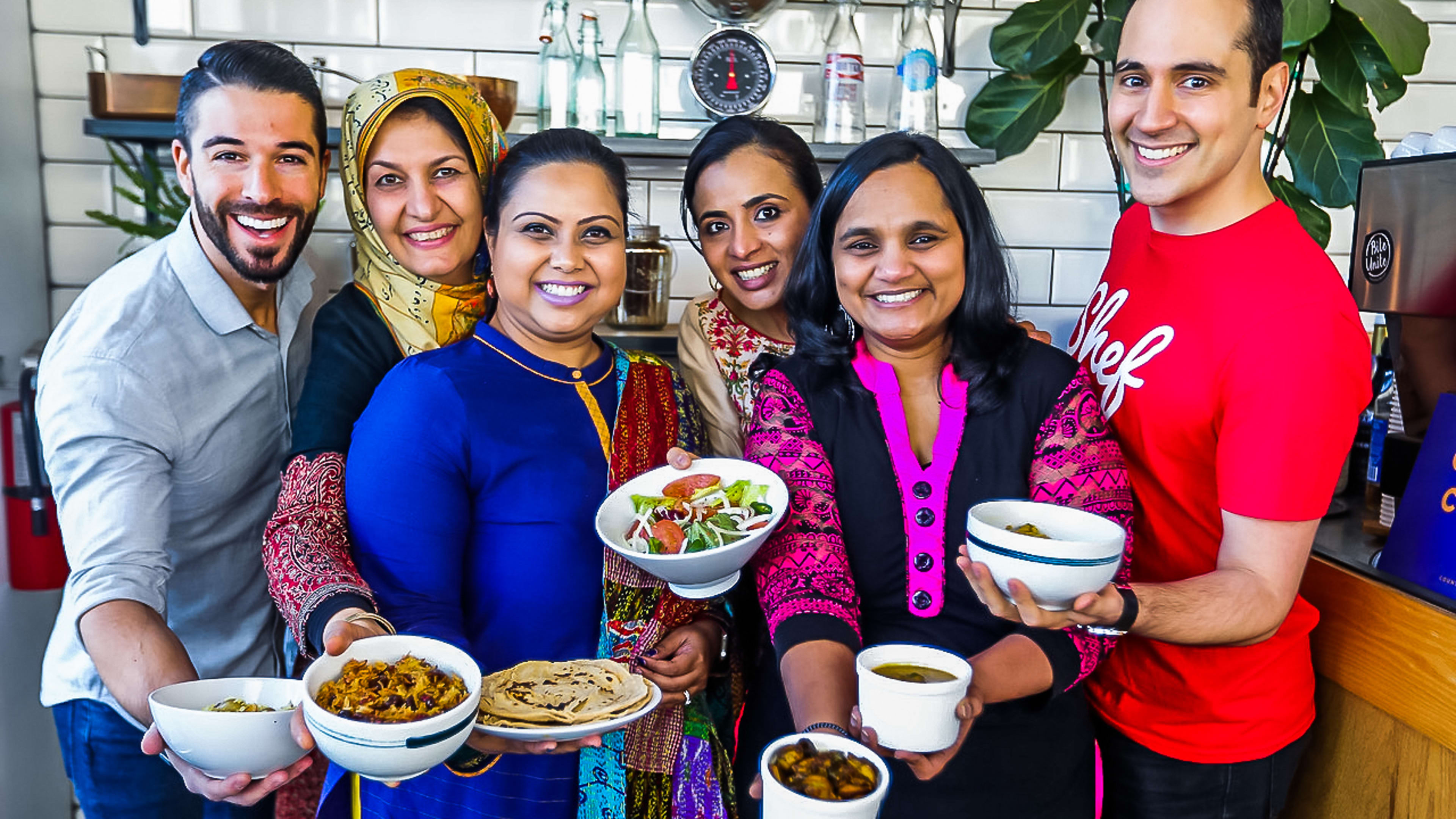Many immigrants settling in the U.S. under devastating circumstances have little choice but to rebuild lives from scratch and secure stable incomes. That will soon be a reality for the first group of approximately 37,000 Afghan refugees resettling in America. In need of swift revenue streams, many in the past have turned to cooking to earn a living, relying on a shared skill many possess in the homeland, says Laila Mir, a stay-at-home mom who came to the 1990s from Afghanistan with her parents. “Everybody is a great cook,” she fondly says of her compatriots.
Mir cooks and sells authentic Afghan meals via Shef, an online platform that allows immigrants to start their own businesses selling home-cooked food, while the company provides tech, regulatory, and marketing support. The offering has become more important during COVID-19 as a way to make money in the safety of your own home—and its also been helpful as new Afghan refugees are coming to resettle in the U.S. Chefs say that it’s also become a way to counter negative media coverage or xenophobic sentiments, in getting the community to embrace their culture through their food.

The Shef site is similar to a DoorDash or Grubhub: customers can browse menus in their area and pick food they want to order. But, they’ll also see the names of the chefs, and cuisines tend to be more diverse than the regular offering, including Nepalese, Taiwanese, and Haitian. Unlike at many restaurants, the cuisines also get very region-specific—not only Indian, but also Punjabi, Gujarati, and Udupi. Customers then place their orders and schedule deliveries a few days in advance, to give chefs time to buy the ingredients and prepare the meals. But also like DoorDash or Grubhub, growing the platform means the company’s model has sometimes pushed the boundaries of industry regulations, in ways that create questions about the future of home cooking startups, the gig economy, and food safety laws.
Just like mama used to make
Alvin Salehi knows firsthand that starting and maintaining a restaurant business is financially precarious. His parents came to the U.S. from Iran in the 1970s, and set up a restaurant that they eventually had to shutter. “That was supposed to be a big inflection point for our family,” he says. “[But] it became very clear that on a good day, they were barely able to break even.” As the average price of starting a restaurant is around $275,000, Salehi knew that route was cost-prohibitive for many. So, he aimed to start a platform to bring the food industry to where they already were: at home. He cofounded Shef in 2019 with Joey Grassia, a former marketing employee for Facebook and food startup entrepreneur.
Mir has now been cooking at home via Shef for six months. She says the initial on-boarding process wasn’t so much difficult as it was rigorous. That’s by design, says Salehi—who became familiar with intensive regulatory processes during his government days, when he worked as a senior tech advisor for the Obama White House. In order to comply with complex food safety regulations, chefs-to-be go through food safety certification exams, food quality assessments, and receive hairnets, masks, and thermometers, and they must retain a high rating on the site. Salehi says Shef has a waitlist of 16,000, caused not just by high demand from prospective cooks, but the slowness of safety procedures.
Rather than work for the company, chefs work independently as 1099 contractors, similar to the Uber-driver model. The intention is that they can keep flexible schedules—Mir works three days a week—though it also means they’re responsible for securing their own health insurance. Mir admits it’s currently hard to make a decent profit because of the high price of ingredients—halal meat has tripled in cost—and because people expect home cooks to charge less than restaurants. Cooks set their prices; you might find a mung bean dal and rice for $7.99, a butter chicken for $9.99, and a Thai panang curry for $8.99. Shef takes a 15% transaction fee per order, and says the the average earning per chef is $40 an hour.

Salehi doesn’t intend for Shef to replace restaurant outings, rather complement them, for busy people who want home-prepared meals most nights. In Salehi’s experience, home-cooked dishes—like the Persian yellow-split-pea stew, khoresh gheymeh, that takes him back to his childhood whenever he tastes it—is never quite the same at a restaurant. “It’s a little too oily,” he says, “[and] you don’t really feel great about it afterward.” The “homemade” notion refers to the style of cooking—using recipes passed down generations from “mothers and aunties”—rather than the location where it’s prepared. Because though the original intention was to create entirely home-based enterprises, many of the chefs legally cannot cook from home.
Navigating stringent food laws
In many states, food laws are restrictive, and most only approve shelf-stable foods, like pies, cookies, or jams, to be produced at home. Only California and Utah permit cooks to sell full meals from home kitchens. But, even in California, which passed the law AB 626 in 2018, counties must opt in, and only seven have done so. Chefs who live in any of the other 51 counties of California—or the entire rest of the country—legally have to cook in shared commercial kitchens, such as ones in San Francisco and Seattle with which Shef partners.
One of the advocacy groups that helped push through the California law is the nonprofit, Cook Alliance. Its founder, Matt Jorgensen, was a cofounder of a startup called Josephine, one of the original companies that pioneered the idea of helping home cooks sell food to neighbors. Josephine shuttered in 2018. “We tried to do it like a cannabis club, to sidestep the regulations,” he says, before realizing they really had to change the law first. His alliance tracks platforms that opened up after the law passed, which he counts at more than 50. These platforms started “with the narrative of, ‘hey, this is legal now,'” he says. “And, it’s not quite true.”
Shef received $8.8 million in seed funding, and $20 million in Series A from Andreessen Horowitz, Y Combinator, and celebrity investors including Katy Perry and Padma Lakshmi. Jorgensen knows firsthand that investor involvement can lead to regulation flouting in the short term. “There’s a growth curve that becomes expected that just, frankly, isn’t super compatible with the pace of regulatory change, or even just like cultural adoption.” He says he gets emails from cooks, including from Shef, who say they’re confused about laws and can’t get permits.
Some critics suggest the company is pushing responsibility for food safety on to a unmonitored network of amateur cooks. But David Owen, Shef’s head of policy, stresses that the company educates its cooks continuously about local laws and regulations, including via live calls and webinars, for individual states and regions. If credibly alerted by local health officials that a chef is not complying, the company says it will suspend them from the platform, which they have done previously.
Another are of complication is delivery. The original California state law legalizing home cooking startups was based on underground dining clubs or takeout. Now, we’re in the world of on-demand delivery, and regulators are especially scrupulous, making sure that food from home kitchens is handed off directly, without third-party delivery. Shef confirms that in some areas, in order to circumvent those onerous clauses, it uses a “distribution model,” whereby chefs drop meals off to an empty commissary kitchen used as a logistics hub, from which third-party drivers are then allowed to deliver. But, the startup also says that in California counties where AB 626 is fully implemented, chefs who’ve obtained food permits have legally set up systems to have customers directly collect meals from designated pickup locations, eliminating the need for delivery.
A “lifeline” during simultaneous crises
Since the start of the pandemic, 55 home-cooking bills have sprung up across 31 states. Jorgensen, who’s helping craft this next generation of food legislation bills, wants to include delivery allowances. He’s optimistic that new laws will give options to food industry workers who don’t want to go back to low-wage jobs, and want to go it alone. Salehi has also been working with state legislators to help expand opportunities. And, when unemployment surged during COVID-19, the chef base evolved from solely immigrants, Salehi says, to anyone “desperate for a lifeline.”
And now, as initial group of Afghan refugees starts to resettle, including an estimated 5,300 in California, cook Laila Mir has been spreading the word about Shef to family and friends. It will take people time to settle in, but when they’re ready, Shef is creating an emergency fast track for them to circumvent the long waitlist, so they can generate an income as fast as possible.
In the meantime, Shef has also started a donation program, teaming up with local charities to send meals to the newly arrived, funded jointly by the company and customers. Mir has been cooking hundreds of extra meals in recent weeks to send refugees comforting tastes of home after months of residing in camps and trudging from airport to airport. “It’s a lot of work for me,” she says, “but it’s very rewarding.”
But, Mir says most of her customers are not fellow immigrants pining for nostalgia, rather local people open to trying new cuisines. She’s found that sharing her food is a way to educate the community about her heritage, and even change the minds of people who are skeptical about incoming migrants. “Afghanistan is always in the news for negative reasons,” she says. “Being on this platform, and showing the world a good side of Afghanistan through food, it’s just been really meaningful for me.”
Recognize your brand’s excellence by applying to this year’s Brands That Matter Awards before the early-rate deadline, May 3.
